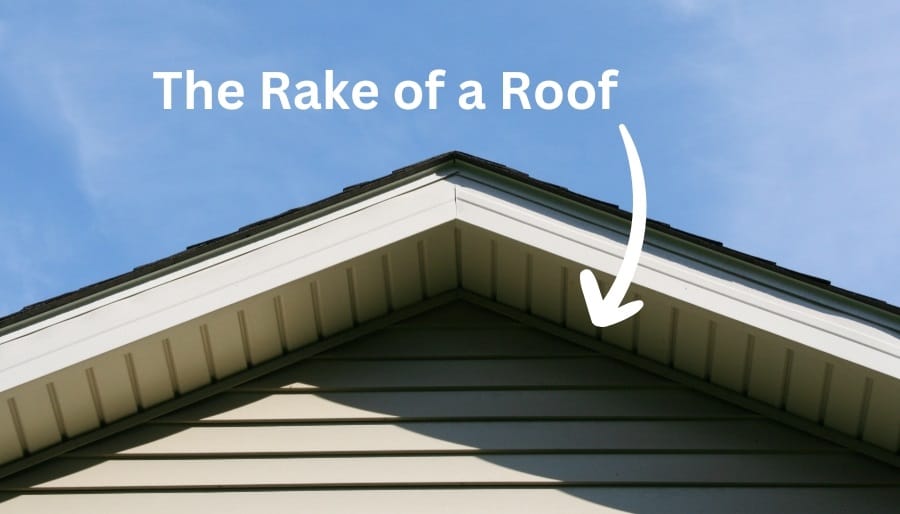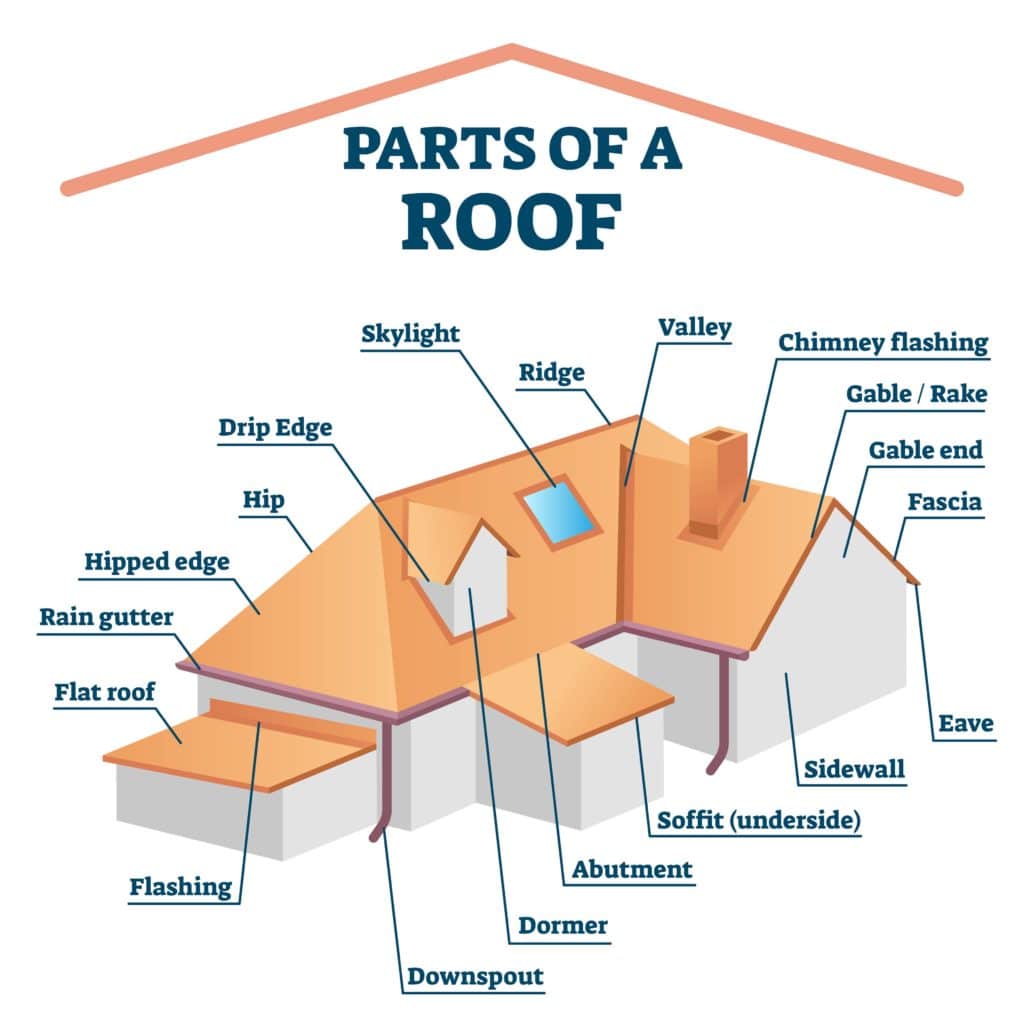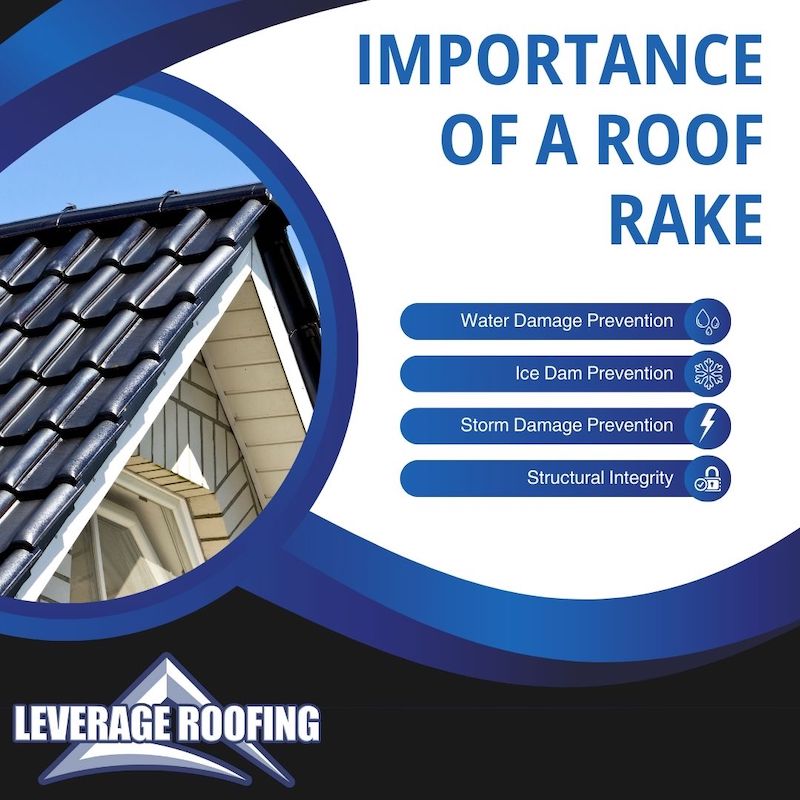Roof Rake: What You Need To Know (Pros & Cons)
Ever looked closely at the edges of a roof and wondered about that angled extension? It's likely a roof rake, a critical component that protects your home from the elements and enhances its curb appeal. But what exactly is it, and why is it so important?
The roof rake, often seen on homes with gabled roof structures, is more than just a decorative flourish. It's a structural element designed to extend from the edge of a pitched roof, creating an overhang or projection. This seemingly simple design serves both functional and aesthetic purposes, protecting the buildings exterior walls and windows from the relentless assault of rain, snow, and sun, while simultaneously contributing to the overall architectural style of the home. Different architectural styles and forms mean a roof rake can manifest in various ways, but its core function remains constant: to safeguard and beautify.
| Aspect | Details |
|---|---|
| Definition | A roof rake is the inclined edge formed at the first and last roofing unit along the sloping ends of the roof, running from the edge of the roof to the ridge. |
| Purpose | Provides proper drainage, prevents leaks, adds aesthetic uniformity to the roof slope, and protects the rake board and fascia from environmental elements. |
| Materials | Vary, including wood, metal, and composite materials. The choice affects longevity, maintenance, cost, and appearance. |
| Design Styles | Exposed and enclosed designs offer different levels of protection and aesthetics. Some rake boards are wrapped in metal to match the aesthetics of metal roofs. |
| Installation Cost | Affected by the material used, the complexity of the design, and labor costs. Budgeting requires multiple quotes, consideration of longevity and maintenance costs, and factoring in additional expenses such as sealants and paint. |
| Website | National Roofing Contractors Association (NRCA) |
Typically, the rake portion of a roof will aesthetically mirror the eave overhang, creating a balanced and harmonious appearance. However, the practical implications of the roof rake extend far beyond mere aesthetics. It provides a stable, flat surface on which to lay the roofing materials, ensuring a consistent and even application. This is crucial for the long-term integrity of the roof, preventing sagging or unevenness that could lead to leaks and other structural problems.
Several factors can significantly impact the cost of installing a roof rake, highlighting the importance of careful planning and informed decision-making. The material chosen, for example, plays a pivotal role. Options range from traditional wood to more modern composites and metals, each offering its own blend of durability, aesthetic appeal, and price point. The complexity of the design is another key consideration. A simple, straightforward rake will generally be less expensive to install than a more elaborate, custom-designed one. Finally, labor costs, which can vary depending on the region and the contractor, must be factored into the overall budget.
To budget effectively for a roof rake installation, homeowners should adopt a strategic approach. The first step is to obtain multiple quotes from different contractors, allowing for a comparative analysis of pricing and services. Its also essential to consider the longevity and maintenance costs associated with different materials. While a cheaper material might seem appealing upfront, it could require more frequent repairs or replacements in the long run, ultimately costing more over time. Finally, dont forget to factor in any additional expenses, such as sealants and paint, which can add to the overall cost of the project.
Understanding the anatomy of a roof rake is essential for both homeowners and roofing professionals alike. With its critical role in protecting the roof and directing water away from the roofing materials, each component plays a crucial part in the overall functionality and performance of the rake. The rake board, for instance, provides a solid edge for the roofing materials to attach to, while the fascia board, which runs along the edge of the roof, protects the underlying structure from moisture and pests. The drip edge, a metal flashing installed under the roofing materials, helps to regulate water flow and prevent water damage to the fascia and underlying roofing materials.
- Jive Turkey Meaning Origin Pop Culture Impact The Full Story
- Blue Ivy Carter In 2025 Whats Next For Beyoncs Daughter
Roof rakes come in several styles, each with unique characteristics and advantages. The most common type features roof sheathing that extends to the edge, providing a clean and streamlined look. Other variations include exposed rakes, where the rafters are visible, and enclosed rakes, which offer a more finished and protected appearance. The choice of style often depends on the overall architectural design of the home, as well as the homeowner's personal preferences.
The rake, also known as a roof edge, refers to the inclined edge formed at the first and last roofing unit along the sloping ends of the roof. It runs from the edge of the roof to the ridge, serving as a crucial element in any roofing system. Its primary functions include facilitating proper drainage, preventing leaks, and providing aesthetic uniformity to the roof slope. Without a properly installed rake, the roof is vulnerable to water damage, structural instability, and an unsightly appearance.
A roof rake serves multiple purposes, ultimately protecting the structure of the home. One key function is directing water away from the roof edges, preventing water damage and helping to avoid ice dam formation in colder climates. By channeling water away from the vulnerable areas of the roof, the rake minimizes the risk of leaks, rot, and other moisture-related problems. It also safeguards the rake board and fascia from environmental elements, extending their lifespan and reducing the need for costly repairs.
When buying a roof rake, various factors come into play. These include longevity, whether high maintenance is required, cost, and the desired appearance. The goal is to strike a balance between affordability, durability, and aesthetic appeal. Homeowners should carefully consider their individual needs and preferences when making a decision, taking into account the climate, architectural style of the home, and budget constraints.
Style choices for the rake of a roof can vary, with exposed and enclosed designs offering different levels of protection and aesthetics. For instance, some rake boards are wrapped in metal to match the aesthetics of a metal roof, creating a cohesive and visually appealing look. The choice between exposed and enclosed rakes often comes down to personal preference, as well as the overall design of the home. Exposed rakes can add a rustic or traditional touch, while enclosed rakes offer a more modern and streamlined appearance.
Is a roof rake the same as a roof eave? Now that you know what a rake is on a roof, youre probably wondering if its the same thing as a roof eave. This is a common misconception. While both are essential components of a roofing system, they serve different functions and are located in different areas of the roof. The eave is the area where a roof extends slightly past the wall of a building, typically running horizontally along the bottom edge of the roof. The rake, on the other hand, is the inclined edge that runs along the sloping sides of a gable roof.
Rake boards, although primarily aesthetic, serve as an added defense against moisture entering your home or roofing system. They act as a barrier, preventing water from seeping into the vulnerable areas of the roof and causing damage. Their most common problem is moisture itself, as prolonged exposure to rain and snow can lead to rot, decay, and structural weakening. It's important to check for cracked, damaged, or rotting rake boards around your home, as these can compromise the integrity of the roof and lead to more serious problems down the line.
A roof rake is a structural component that extends from the edge of a pitched roof, creating an overhang or projection. This design element serves both functional and aesthetic purposes, helping to protect the buildings exterior walls and windows from the elements while also contributing to the overall architectural style of the home. The overhang created by the roof rake helps to shield the walls from rain and sun, preventing water damage and fading. It also adds visual interest to the roofline, enhancing the curb appeal of the home.
It also provides a stable, flat surface to lay the roofing materials on, ensuring a consistent and even application. This is crucial for the long-term integrity of the roof, preventing sagging or unevenness that could lead to leaks and other structural problems. A properly installed roof rake will provide a solid foundation for the roofing materials, ensuring that they are securely attached and able to withstand the elements.
The water shield, or water barrier, is an adhesive layer applied to the deck to protect it from the elements, particularly melting ice and heavy rainstorms. This layer is extremely important for protecting the vulnerable wooden frame and deck, preventing water from seeping in and causing rot, mold, and other moisture-related problems. Without a water shield, the roof deck is exposed to the elements, making it susceptible to damage and compromising the overall integrity of the roof.
While the roof rakes primary purpose is functional, it also plays a key role in your homes curb appeal. A well-designed and properly maintained roof rake can significantly enhance the visual appeal of the home, adding character and charm. When considering the aesthetics of your roof rake, its important to choose materials and styles that complement the overall architectural design of the home.
There is a difference between these two terms. The rake of a roof, as explained above, is the exposed portion on the sides of a gable roof that extends from the eave to the ridge of the sloped sides. It covers the top edge of a roof, while a roof rake is used for removing snow from the roof of a house. It's important to distinguish between these two terms, as they refer to different aspects of the roofing system.
A roof is more than just shingles or tiles thrown over a house. Each important part, including the roof rake, works together like a constructed puzzle to provide protection and aesthetics to your home. Every component plays a vital role in the overall performance and longevity of the roof, working in harmony to shield the home from the elements and enhance its curb appeal.
The purpose and importance of a roof rake go beyond aesthetics. It serves a number of essential roles, protecting the structure of the home from water damage, preventing ice dam formation, and enhancing the overall appearance of the roof. Its functions are multi-faceted, contributing to the long-term integrity and value of the home.
Underlayment options include felt, synthetic, and rubberized asphalt, allowing you to choose the best fit for your needs (source: Types of roof underlayment, 2023). The choice of underlayment material can significantly impact the roofs performance, providing an added layer of protection against water damage and other environmental factors. Each type of underlayment offers its own unique blend of advantages and disadvantages, so its important to carefully consider your individual needs and preferences when making a decision.
Finally, the roofing material itself, such as asphalt shingles or metal roofing, impacts the roof's durability, cost, and appearance. The choice of roofing material is a major decision, as it affects not only the roofs aesthetic appeal but also its long-term performance and maintenance requirements. Each type of roofing material offers its own unique set of benefits and drawbacks, so its important to carefully weigh your options before making a final decision.
Defining the rake of a roof: the rake of a roof or a roof rake not to be confused with the tool also called a roof rake is a part of any gabled roof. Specifically, its the exposed part of a gabled roof that extends from an eave to the ridge of the roofs sloped sides. It covers the top edge of a roof and is typically cut from a single piece of lumber.
Ensure your drip edge flashing is compatible with the shingles or roofing material used on your roof. Proper drip edge installation is key, as it plays a critical role in preventing water damage to the fascia and underlying roofing materials. A properly installed drip edge will direct water away from the vulnerable areas of the roof, ensuring that it flows smoothly and efficiently into the gutters.
If youre unsure about the type of roofing material to use, consult with a qualified roofing professional. They can assess your individual needs and preferences, providing expert guidance and recommendations on the best options for your home.
They provide a secure base for insulation to be installed, reducing heat loss and lowering energy bills. By preventing air leakage, the roof rake helps to maintain a consistent temperature inside the home, reducing the strain on the heating and cooling systems and lowering energy consumption.
When it comes to the rake of your roof, there are several common problems that homeowners might encounter. These include rot, decay, and insect infestation, all of which can compromise the structural integrity of the roof. Regular inspections and maintenance are essential for identifying and addressing these problems before they escalate into more serious issues.
A rake rafter is a specially designed roof rafter or truss that creates the rake of a roof, which is the overhang on the sloped edges. These rafters are engineered to provide the necessary support and stability for the roof, ensuring that it can withstand the elements and maintain its structural integrity.
Indeed, there is a difference. As mentioned earlier, the rake of a roof pertains to the sloped overhangs. The roof rake is the exposed portion on the sides of a gable roof that extends from the eave to the ridge of the sloped sides. It's important to understand this distinction, as the two terms are often used interchangeably, leading to confusion.
An eave is the area where a roof extends slightly past the wall of a building. Its an essential component of a roofing system, providing protection to the walls and foundation from rain and snow.
The roofing material that lies between the roof decking and shingles is the underlayment. It serves as a protective barrier, preventing water from seeping into the roof deck and causing damage. The underlayment is an essential layer of defense against the elements, ensuring the long-term integrity of the roof.
A drip edge is simply a metal flashing installed under the roofing materials to help regulate water flow from the fascia and protect any underlying roofing materials. It contains a small metal flange that directs water away from the fascia, preventing water damage and extending the lifespan of the roof.
Install drip edges on your roofs eaves, gable, and rake. This is a crucial step in protecting the roof from water damage, ensuring that water is properly channeled away from the vulnerable areas of the roof.
Here are 16 roofing terms you need to know if you're a contractor! Having a solid understanding of roofing terminology is essential for any roofing professional, allowing for clear communication and effective collaboration on roofing projects.
When designing roof eaves, several factors must be taken into consideration, including the roof's pitch, the climate, and the building's architectural style. These factors all play a role in determining the optimal design and functionality of the eaves.
The roof's pitch determines how far the eaves will project from the building's walls. A steeper roof pitch means the eaves will be shorter, while a flatter pitch allows for longer eaves. The pitch of the roof is a critical factor in determining the overall design and functionality of the roofing system.
If your clients value low maintenance, these materials are the best options. Choosing low-maintenance roofing materials can save homeowners time and money in the long run, reducing the need for frequent repairs and replacements.
Roof rake design and functionality are intertwined. Roof rakes are both a design element and a practical part of a roofs structure. Its important to balance the two, ensuring that the roof rake not only looks good but also performs its essential functions effectively.
The first decision is whether the rake will be overhanging or flush with the wall. This choice affects the aesthetics of the roof, as well as its ability to protect the walls from rain and sun.
While these roofs are popular in commercial buildings and modern homes, they can pose challenges related to water drainage. Flat roofs require careful planning and execution to ensure proper water drainage, preventing ponding and potential leaks.
According to the code section we just read above, the drip edge must be provided at the eave edge and rake edge of a roof. This is a critical requirement for ensuring proper water drainage and protecting the roof from water damage.
When installed along the roof rake, the drip edge is applied over the underlayment and when installed along the roof eave, the drip edge is applied under the underlayment. This ensures that water is properly channeled away from the vulnerable areas of the roof, preventing leaks and extending the lifespan of the roofing system.
- Charles Barkleys Wife Maureen Blumhardts Untold Story Details
- Harrison Ford Raiders Wildfires Beyond The Latest News

What Is The Rake of a Roof? Explained! Building Code Trainer

What Is The Rake Of a Roof? Boggs Inspection Services

What's a Roof Rake? Roofing System Explained